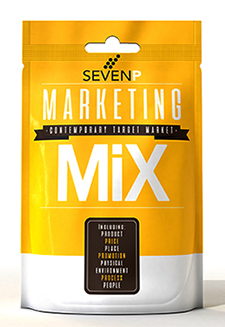

Marketing Mix is defined as “A combination of marketing tools a firm uses to pursue its marketing objectives.” (Dictionary.com) When the term was first used in the late 1940s to help companies develop marketing for its products, it comprised 4Ps: product, place, price, and promotion. As the service industry grew, 3Ps (physical evidence, people, and process) were added to aid in their marketing.
Law firms can use the 7Ps of the marketing mix to review their competitive strategies. Marketing comprises numerous tools to ensure you reach your target audience and sales goals. However, when viewed individually, each tool has its strengths and weaknesses, so combine them to ensure a successful campaign that positively affects your bottom line.
Starting with the original 4Ps, created by academic E. Jerome McCarthy, let’s look at each:
Product refers to an item or a service that satisfies a customer’s needs or wants. Product decisions include the product or service quality, benefits, branding, warranties, returns, life cycles and returns, or reviews.
Price refers to the total cost to the customer for the service or product. Price decisions for law include flat fees, hourly rates, credit payment, and terms.
Place is defined as “direct or indirect channels to market, geographic distribution, territorial coverage, retail outlet, or market location.” (Wikipedia) Place can be a physical location, virtual office, or catalog. Convenience for consumers is a consideration.
Promotion refers to the marketing communication used to make services known to prospective customers and to persuade them further. Your promotional mix includes advertising, public relations, direct marketing, internet marketing, and networking.
In the 1980s, in an effort to include the rise of service businesses in the marketing mix, marketing firm Booms and Bitner added the following service mix Ps:
People are the lawyers and staff that provide the firm’s services. They are the product and, as such, impact the public’s perception of the firm as much as a tangible product. As part of your marketing plans, it is important that the people represent the firm in line with its broader messaging strategy. This is accomplished through recruitment, training of new staff, social interactions, and handling complaints.
Physical Evidence refers to your office, including furniture, equipment, access, parking, décor, signage, and logo. The law, with its shift to a paper-free environment, has little physical evidence of the services provided. If clients want paper, it can be provided; however, some prefer to store their documents in the cloud and to have all communication through email. Whatever choice is made, some form of evidence is important to assure that the firm has provided what the customer wants.
Process is the procedures and flow of activities by which a service is given. It represents the flow of work through the firm as each staff member has a role. From the moment the client is greeted by a receptionist to the completion of work by the lawyer, an impression is being made. Office manuals and proper training can assure the process supports the firm’s goals.
If you use the 7Ps of the marketing mix to audit your efforts, it’s important to assess each part. Doing so will assure you’ve developed a marketing strategy that will support the firm long into the future.
 After years practicing law, Roberta Gubbins served as editor of the Ingham County Legal News. Since leaving the paper, she provides writing services to lawyers ghostwriting content for websites, blogs, and articles. She is editor of The Mentor, the SBM Master Lawyers Section newsletter.
After years practicing law, Roberta Gubbins served as editor of the Ingham County Legal News. Since leaving the paper, she provides writing services to lawyers ghostwriting content for websites, blogs, and articles. She is editor of The Mentor, the SBM Master Lawyers Section newsletter.
Read More Clear & Convincing Articles
Using the Enhanced Member Directory
How to Login and Edit Your Profile
CloudLawyers Directory Services
How to Contact CloudLawyers Support